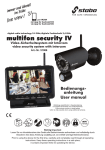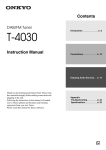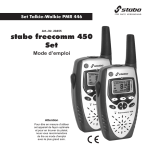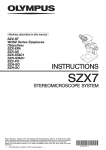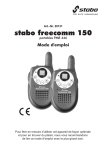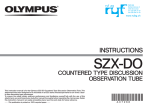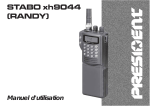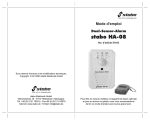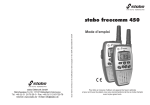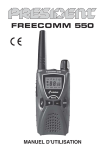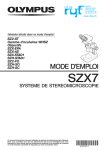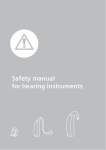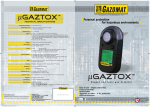Download BdA CO-Alarm GB.FH10 - produktinfo.conrad.com
Transcript
Art.-Nr. / No art 51111 CO alarm Carbon monoxide detector User Manual EN 50270 Important Prior to using the device for the first time, carefully and completely read through all operating instructions. Keep these operating instructions in a safe place, it contains important hints for operating the device. Introduction Carbon monoxide (CO) is a colorless, odorless and tasteless gas which is toxic and can quickly become a mortal danger. Amongst others, carbon monoxide is formed during incomplete combustion processes (e.g. in case of a defective heating boiler or clogged chimney). The battery powered stabo CO alarm is designed for stationary use in residential houses: It already detects low concentrations of carbon monoxide and emits both an acoustic (85 dB/3 m) and an optic warning signal (red blinking LED) in case of danger. However, the electrochemical sensor is only able to early detect gas particles in a limited area! Furthermore, a CO alarm is not a substitute for smoke, fire, or other detectors. It does not detect neither smoke nor heat nor other gases. Signs of a carbon monoxide poisoning Carbon monoxide binds to the dye of the red blood cells thus hindering the transport of oxygen, which can lead to death by suffocation. A high CO concentration might lead to death within a few minutes! Typical signs of poisoning at low CO concentration: mild headache, nausea, fatigue (fluelike symptoms), medium CO concentration: strong headache, tachycardia, vomiting, high CO concentration: spasms, confusion, unconsciousness, cardiac arrhythmia. Please bear in mind that the symptoms might also occur earlier in small children, pregnant women, seniors and persons with lung and heart diseases and that low CO contaminations possibly might cause already organ damage in unborn babies. Preventive measures Ensure that any installation of gas powered units/systems is carried out exclusively by qualified personnel. Make sure that your units/systems are always in a perfect technical condition and have them checked regularly. Take care that stoves, fireplaces, chimneys and the like are always clean. 2 Never use barbecue grills, terrace stoves, heaters, or other devices, which are designed for outdoor use, in confined areas. Safety notes and warnings Be sure to observe the given preventive measures! Make sure that your entire living space is covered by the CO alarm to the best possible extent: One device is only able to early detect gas particles in a limited area! Install the CO alarm in a fairly accessible place (cleaning/tests/ exchange of batteries)! Each CO alarm device should be checked once a week. Never coat, paint over the housing of the CO alarm device or stick something on it! The openings of the housing must always remain free and open and may not be covered by curtains or the like. When a warning because of a weak battery is emitted, immediately exchange the three batteries. Prevent your children from playing with the device or the batteries! Never open the housing of the CO alarm! Present the CO alarm to all residents such that the alarm signal is well know and can be reliably distinguished from other buzzers or (door) bells installed in the house. Explain the meaning of the CO alarm to children and needy persons and tell them what to do in the event of an alarm. Exchange the CO alarm three years after its manufacturing at the very latest (the date of manufacture is mentioned on the type plate). Behavior in the event of an alarm Immediately go outdoors or to a window wide open! If necessary, alert the other residents as well. Call the fire brigades/rescue services and follow their instructions. Do not enter into the affected area before the CO concentration has reached uncritical values by thoroughly ventilating the affected room: Afterwards, the alarm is automatically terminated and the device returns again to normal mode. 3 Determine the CO source and take remediate action immediately (depending on the cause, for instance, by having the device repaired or the chimney cleaned by a specialist). Installation and commissioning Selection of an appropriate installation site For achieving an optimum safety, install respectively one CO alarm in each bedroom, in all rooms equipped with gas heating, stove/oven or fireplace as well as in the hallway on every floor. (If you decide to only install one device, choose an appropriate installation position such that a possible alarm can be heard in all bedrooms!) CO has nearly the same density as air: it does not concentrate on the floor but mixes evenly with the air in the room. Therefore install the CO alarm as central as possible on a free, unobstructed area (e.g. in the middle of the ceiling). In rooms with a potential source of hazard, install the CO alarm in their proximity (at a dis-tance of approx. 2-3 m). The device can also be wall-mounted (approx. at eye level): This type of mounting facilitates the maintenance (cleaning/battery exchange) and enables an easy reading of the control units (LEDs, display). However, make sure that the distance to the ceiling and the corners of the room is sufficient (20 cm at least). In any case, the openings of the housing must always remain free and open and may not be covered by curtains, furniture or the like! The CO alarm should not be mounted in very cold (below 5° C) or very warm rooms (above 40° C) as well as in rooms which are very humid or exposed to dust, dirt or fat. The immediate proximity of fluorescent tubes, ventilators, or other sources of draft is to be avoided as well. Installation and commissioning Remove the mounting plate from the alarm device (by slightly turning it counterclockwise). Mark the drill holes at the planned mounting position (using the mounting plate as drilling jig), drill the corresponding holes (make sure not to damage any lines!) and fix the mounting plate afterwards by means of the enclosed dowels and screws. 4 Remove the insulating strip located between battery and battery contact. The CO alarm device emits a beep for confirming its commissioning, the red LED briefly lights up and 888 PPM is briefly indicated on the display. Turn the CO alarm device clockwise on the mounting plate until it locks in place. Check the CO alarm functions by pressing the test/reset key (however, when doing so, hold the device at arms length for protecting your ears). Indications and functions LC display In normal mode, the display is switched off. However, if the electrochemical sensor detects carbon monoxide, the LCD shows the determined CO concentration in ppm/parts per million (values between 30 ppm and 999 ppm are displayed). Memory function with highest level indication If carbon monoxide has been detected during your absence, but the CO alarm is already reset to normal mode since any CO contamination cannot be detected anymore, the device stores the determined CO peak value. By pressing the test/reset key (for approx. 5 sec.), a possibly stored highest level is displayed. By pressing the test/reset key once again, the CO alarm afterwards returns again to normal mode. The highest level memory is deleted by pressing the test/reset key or by exchanging the battery or when an alarm is triggered again. Battery warning When the battery voltage becomes weak, the CO alarm starts to beep (approx. every 30 sec.), both LEDs flash and the display shows Lb (low battery). The CO alarm is now only operable for another 7 days approximately: Thus, exchange the batteries as soon as possible! 5 Green LED If the green operating LED briefly flashes every 30 sec., the CO alarm functions properly. Red LED The red LED always indicates an alarm signal! It flashes when a carbon monoxide alarm is triggered or the device is not operable anymore since the battery capacity has been used up. Acoustic alarm signal The flashing of the red LED is always accompanied by an acoustic alarm signal! When a carbon monoxide alarm is triggered, an alarm signal with a noise level of 85 dB is emitted every 5 sec. (and the red LED flashes). After an alarm duration of 4 minutes, the alarm sound continues with the same volume, but the signal cycle slows down: The alarm signal now sounds every minute and not every 5 seconds. By pressing the test/reset key, the alarm can be switched off for several minutes: But it will be triggered again afterwards, if the CO concentration is still critical. The alarm is automatically switched off, if there is no danger anymore. If the CO alarm emits a beep approx. every 30 sec. (please refer to chapter Battery warning), the battery capacity is used up. Test function Test the CO alarm once a week! Do not expose your ears directly to the alarm signal, but hold the device at arms length and briefly press the test/reset key. The CO alarm emits 3 beeps, the red LED flashes rapidly and the LC display shows 000 PPM. This process is repeated once again. Afterwards the CO alarm returns to normal mode and 000 PPM is no longer indicated on the LC display. Alarm muting Strong draft, solvent vapors or the like can trigger an alarm. In this case, the CO alarm can be muted by pressing the test/reset key. You should only use this function, if it is clear that this alarm has been triggered due to a harmless cause! 6 Function table Sound approx. every 30 sec. green power LED flashes approx. every 30 sec. flashes red alarm LED off off off flashes rapidly off off blinkt schnell emits 3 beeps Alarm sound every 5 sec., after 4 min. every minute. flashes LC display Meaning off Operable: normal mode Lb battery warning (=> Exchange batteries!) 000 PPM Test function off device not operable (=> Exchange batteries or device!!) z.B. Alarm triggering! 100 PPM (=> Immediately go outdoors, Call rescue services!) Maintenance and care Keep your CO alarm clean! Regularly vacuum clean the device with caution or clean it using a slightly damp, lint-free cloth. You should never use solvent-based detergents! In immediate proximity of the CO alarm, do not use any aerosols (e.g. air fresheners, hairspray) or other chemicals (e.g. paints/lacquers). Uninstall the CO alarm before carrying out renovation or cleaning works using solvents and keep it in a closed plastic bag as long as all work is performed in order to prevent soiling the sensor. Battery exchange The batteries are to be exchanged after one year and/or immediately when the battery warning sounds. Always exchange the three batteries. Please use nothing but 1.5 V batteries (AA/mignon), we recommend to use Duracell MN 1500 or Energizer E91. Make sure to insert the new batteries with correct polarity: This will be confirmed through a brief beep of the CO alarm. Attention: If one of the batteries is not inserted correctly, the device is not operable! New batteries will last for approx. 1 year. However, the lifetime of the batteries can be reduced by frequent function tests or alarm triggering as well as by very high or low ambient temperatures or a high humidity. 7 After each battery exchange, make sure to check the proper functioning of the CO alarm (see test function). Hand in used batteries at the corresponding collecting point batteries are not to be thrown into the domestic waste! Technical data Battery operation 3 x 1.5 V alkaline (AA/mignon) Calibrated according to EN 50291 Signal volume approx. 85 dB/3 m Dimensions Ø 125 mm, height 33 mm Lifetime of CO alarm approx. 3 years Triggering threshold according to EN 50291 CO concentration in ambient air 50 ppm 100 ppm 300 ppm Alarm triggering after 60 - 90 minutes 10 - 40 minutes 3 minutes Disposal instructions Electronic devices and used up batteries are not to be thrown into the domestic waste. Hand in the used batteries at the corresponding collecting point. Hand in the device at your municipal waste disposal company or a collecting point specialized in electronic scrap. Disclaimer stabo shall not be liable for damage of any kind (including individual or consequential damage) resulting from the fact that the signal of the CO alarm was not activated in the presence of carbon monoxide. Furthermore, stabo shall also not be held liable for the consequences of false or deceptive alarms: Costs resulting, for instance, from operations of the fire brigades or key services are not covered. Errors and technical modification reserved. Copyright © 02/2011 stabo Elektronik GmbH stabo Elektronik GmbH . Münchewiese 14-16 . 31137 Hildesheim/Germany Tel. +49 (0) 5121-76 20-0 . Fax: +49 (0) 5121- 51 29 79 Internet: www.stabo.de . E-Mail: [email protected] 8








